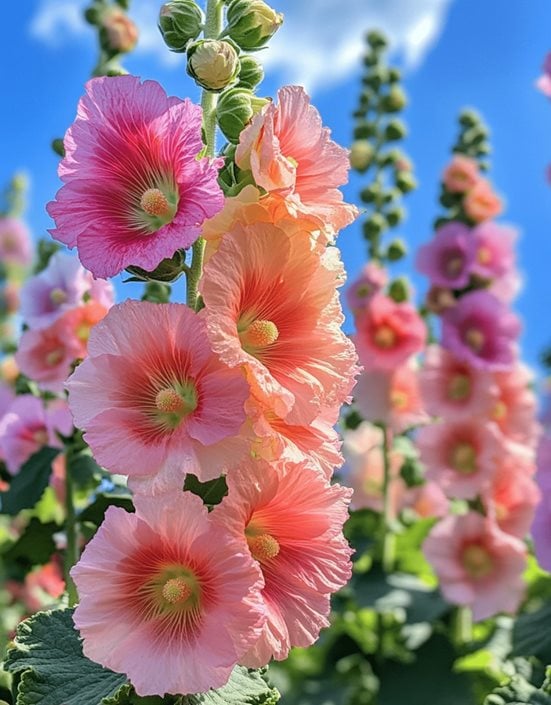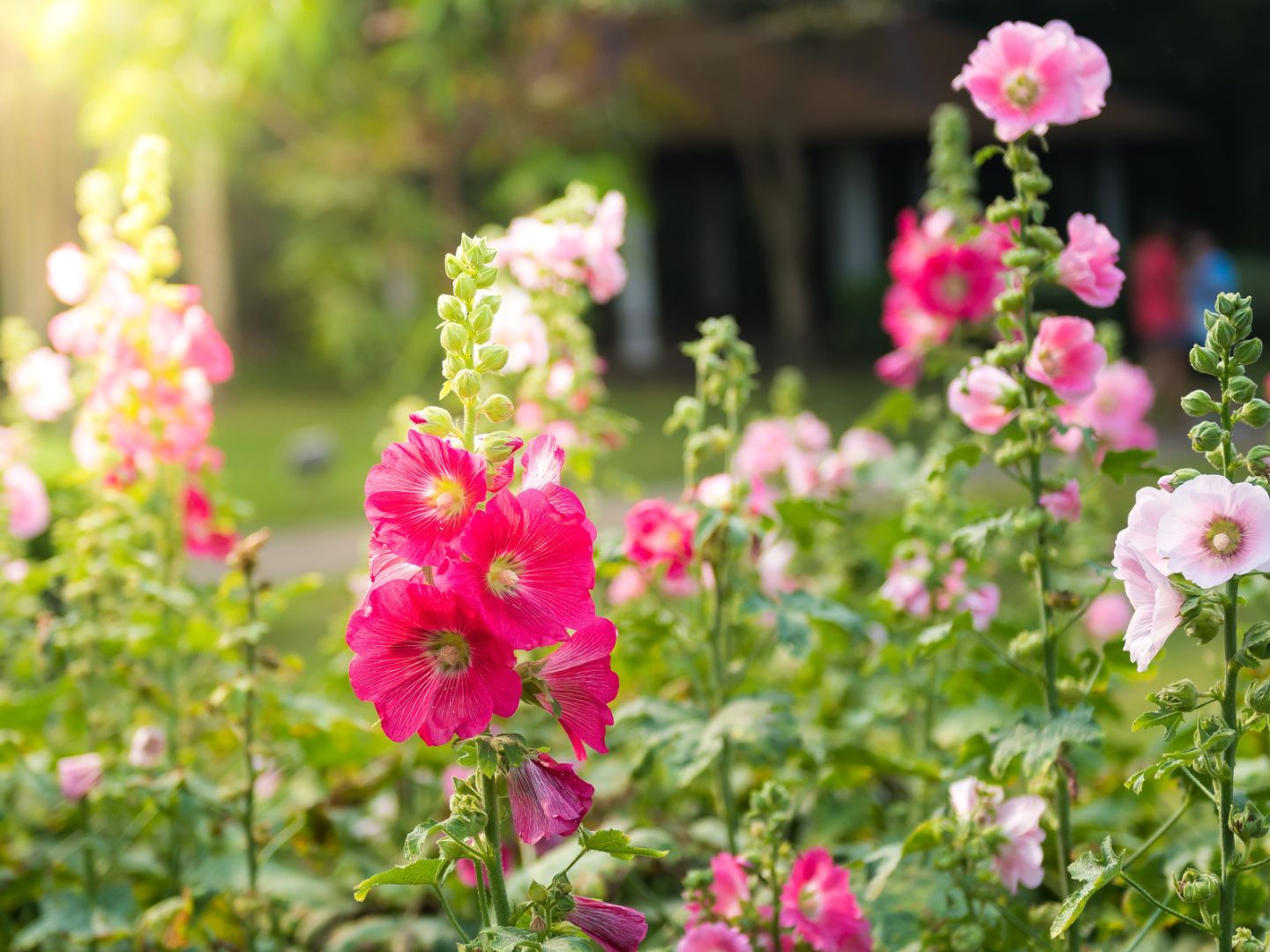10 Tips For Heavenly Hollyhock Blooms
Transform your garden with these expert guidelines for growing magnificent hollyhocks
:strip_icc()/pink-alcea-rosea-hollyhock-barn-4540b8ea-309c3d74cee64f2eabb42f5980f64a33.jpg)
About Hollyhocks
Hollyhocks (Alcea rosea) are beloved cottage garden classics known for their towering spikes of colorful blooms. These striking biennials or short-lived perennials can reach heights of up to 8 feet, creating a dramatic vertical element in gardens. With proper care, they’ll reward you with abundant flowers that attract pollinators and add old-world charm to your landscape.
Choose the Perfect Spot
Sun Exposure: Hollyhocks thrive in full sun locations with at least 6-8 hours of direct sunlight daily. Insufficient light causes weak, spindly growth and poor flowering.
Wind Protection: While they need good air circulation, hollyhocks benefit from protection against strong winds that can damage their tall stalks. Consider planting near a fence or wall for support.
Pro Tip: East, south, or west-facing garden areas typically provide ideal sunlight conditions for hollyhocks.
Prepare Fertile Soil
Hollyhocks perform best in well-draining, fertile soil with a pH of 6.0 to 7.0. Though adaptable to various soil types, they dislike waterlogged conditions.
Soil Preparation: Before planting, amend your garden soil with plenty of organic matter such as compost or well-rotted manure to improve fertility and drainage.
Pro Tip: Add coarse sand to heavy clay soils to improve drainage and prevent root rot issues.
Perfect Spacing & Planting

Proper Spacing: Space hollyhocks 18-24 inches (45-60 cm) apart to allow sufficient air circulation, which helps prevent disease problems.
Planting Depth: When planting seeds, sow them just 1/4 inch deep. For transplants, ensure the crown sits at soil level.
Pro Tip: For continuous blooms, stagger your planting times or plant both first and second-year plants together.
Smart Watering Techniques
Watering Needs: Keep soil consistently moist but not soggy, especially during establishment and bloom time. Mature plants can tolerate some drought.
Watering Method: Always water at the base of plants rather than overhead to keep foliage dry and reduce disease risk, particularly rust.
Water deeply once or twice a week depending on weather conditions, rather than frequent shallow watering that encourages weak root systems.
Pro Tip: Apply a 2-3 inch layer of mulch around plants (keeping it away from stems) to retain moisture and suppress weeds.
Proper Fertilization
Hollyhocks aren’t heavy feeders, but benefit from moderate fertilization to produce abundant blooms.
First Application: Apply a balanced fertilizer (10-10-10) in early spring as new growth emerges.
Mid-Season: A light application of fertilizer when buds begin forming helps support blooming.
Pro Tip: Avoid high-nitrogen fertilizers which promote lush foliage at the expense of flowers. Top-dress with compost in spring for slow-release nutrition.
Prevent Hollyhock Rust

Rust is the most common disease affecting hollyhocks, appearing as orange-brown pustules on leaf undersides.
Prevention:
- Space plants properly for air circulation
- Water at the base, not on foliage
- Remove and dispose of infected leaves immediately
- Clean up all plant debris in fall
Pro Tip: Apply a thick layer of mulch in early spring to prevent rust spores in the soil from splashing onto new growth.
Support Tall Stalks
Hollyhocks can reach 6-8 feet in height and often need support, especially in windy locations.
Staking Methods:
- Install stakes early in the growing season before plants become top-heavy
- Use bamboo poles or sturdy garden stakes
- Attach stems loosely to supports with soft garden twine
- Consider decorative support structures like obelisks for an ornamental touch
Pro Tip: Planting hollyhocks along walls or fences provides natural support and creates a stunning backdrop effect.
Deadheading for More Blooms
Regular Deadheading: Remove spent flowers promptly to encourage continued blooming and prevent self-seeding if desired.
Technique: Cut flower stalks back to a set of healthy leaves or side buds after the majority of blooms on the stalk have faded.
For varieties you want to self-seed, leave some spent flowers in place at the end of the season.
Pro Tip: Deadheading also improves the overall appearance of your hollyhocks and helps reduce disease pressure by removing aging plant material.
Fall & Winter Care

End-of-Season Cleanup: After flowering completes and foliage dies back in fall, cut stems down to about 6 inches above ground level.
Disease Prevention: Remove and destroy (don’t compost) all plant debris to minimize rust spores overwintering in your garden.
Winter Protection: Apply a light mulch around plant bases in cold regions after the ground freezes to prevent frost heaving.
Pro Tip: Mark hollyhock locations before winter cleanup to avoid disturbing them during spring garden activities.
Choose Rust-Resistant Varieties
Selecting disease-resistant hollyhock varieties can significantly reduce rust problems and maintenance needs.
Recommended Varieties:
- Alcea ‘Halo’ Series – More rust-resistant than traditional varieties
- Alcea rugosa – Russian hollyhock with excellent disease resistance
- Alcea ‘Queeny Purple’ – Compact variety with better disease tolerance
- Alcea ‘Fiesta Time’ – Semi-double blooms with good disease resistance
Pro Tip: For best results, purchase disease-free seeds or plants from reputable suppliers rather than collecting seeds from potentially infected plants.
Growing Heavenly Hollyhocks: Key Takeaways
Ideal Growing Conditions
- Full sun (6-8 hours daily)
- Well-draining, fertile soil
- Proper spacing (18-24 inches apart)
- Protection from strong winds
Essential Care
- Consistent watering at plant base
- Moderate fertilization
- Regular deadheading
- Stakes for support
Rust Prevention
- Good air circulation
- Avoid wetting foliage
- Remove infected leaves promptly
- Thorough fall cleanup
- Consider rust-resistant varieties
Common Issues & Solutions
- Spindly growth → Increase sunlight
- Few blooms → Check fertilizer balance
- Falling over → Install stakes early
- Rust infection → Improve air circulation






